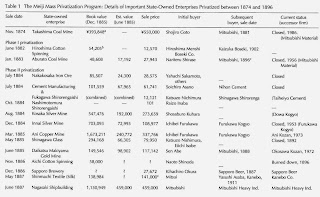But I have now learnt that I was very wrong, 1974 is way too recent. It turns out that the Japanese may have had the first mass privatisation programme. During the period 1874 to 1896 the Japanese government sold 26 large SOEs (Morck and Nakamura 2007).
Details of the sales are given in the tables below (click to make larger), which is Table 1 from Morck and Nakamura (2007: 566-7). It lists the SOEs divested, details of the transactions, and both the immediate and ultimate buyers:
The motivation, as you may well have guessed, was escalating fiscal pressure on the government, and the reluctant acknowledgement that most SOEs were not worth their gross book values. This lead to the beginning of the SOE sales in 1874 with the Takashima coal mine being offered to the highest bidder. Sales continued for the next 20 years, with the last of the 26 sales taking place in 1896. Only a few SOEs escaped the mass privatization—military suppliers, mints, government printing, railways, postal services, and telegraphs.
Refs.:
- Bitran, Eduardo and Raul E. Saez (1994). 'Privatization and Regulation in Chile'. In Barry P. Bosworth, Rudiger Dornbusch and Raul Laban (eds.), The Chilean Economy: Policy Lessons and Challenges (pp. 329-68), Washington D.C.: The Brookings Institution.
- Hachette, Dominique and Rolf Luders (1993). Privatization in Chile: An Economic Appraisal, San Francisco: ICS Press.
- Luders, Rolf J. (1991). 'Massive Divestiture and Privatization: Lessons from Chile'. Contemporary Economic Policy, 9(4) October: 1-19.
- Morck, Randall and Masao Nakamura (2007). 'Business Groups and the Big Push: Meiji Japan's Mass Privatization and Subsequent Growth', Enterprise & Society, 8(3) September: 543-601.


No comments:
Post a Comment